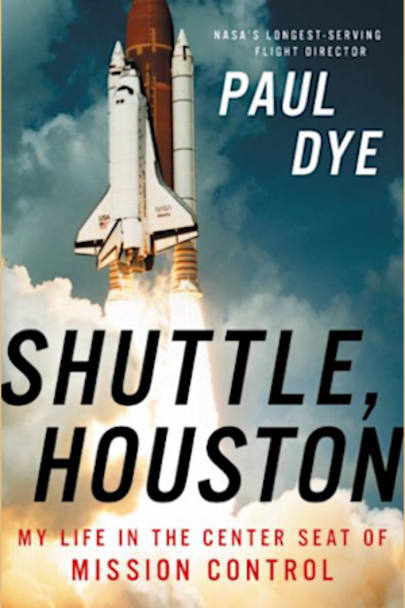From the longest-serving Flight Director in NASA’s history comes a revealing account of high-stakes Mission Control work and the Space Shuttle program that has redefined our relationship with the universe. A compelling look inside the Space Shuttle missions that helped lay the groundwork for the Space Age, Shuttle, Houston explores the determined personalities, technological miracles, and … personalities, technological miracles, and eleventh-hour saves that have given us human spaceflight.
Relaying stories of missions (and their grueling training) in vivid detail, Paul Dye, NASA’s longest-serving Flight Director, examines the split-second decisions that the directors and astronauts were forced to make in a field where mistakes are unthinkable, and where errors led to the loss of national resources — and more importantly one’s crew. Dye’s stories from the heart of Mission Control explain the mysteries of flying the Shuttle — from the powerful fiery ascent to the majesty of on-orbit operations to the high-speed and critical re-entry and landing of a hundred-ton glider.
The Space Shuttles flew 135 missions. Astronauts conducted space walks, captured satellites, and docked with the Mir Space Station, bringing space into our everyday life, from GPS to satellite TV. Shuttle, Houston puts readers in his own seat at Mission Control, the hub that made humanity’s leap into a new frontier possible.



Fascinating. This book is from a guy that started in NASA in the era right after Apollo and seemingly left right as SpaceX and the other private space agencies were finding their first successes. It is highly technical, yet also very approachable – Dye actively tries to explain as much of his “NASA-speak” (his term) as possible while not getting bogged down in too many details. This covers the entirety of his 40 ish years in NASA, from his first days as a co-op student through his last years planning the recovery missions should a Shuttle be stranded in space in the years after the Columbia disaster. Great insight and sometimes hilarious stories, though it ultimately suffers from the same bad taste of an ending that soured Kranz’s Failure Is Not An Option. In its final chapter, it more often comes across as a bitter old man not understanding the new dynamics of the agency he helped mold, rather than as someone truly hopeful for the future of space exploration and what the promise of the new and immediately future eras. Still, a truly worthy read from one of the people who doesn’t have the name recognition of a Kranz or a Chris Kraft, but who was arguably just as important in getting NASA to where it is today. Very much recommeded.
Shuttle, Houston is quite a story as the reader gets to learn about the space program from the inside out. Most if it is fascinating, but I found the first chapters to be technologically above my head. They are very detailed about the mechanics of how things work. However, once I got past that part of the book, it was much easier to follow.
We are provided a lot of information that many of those outside of the space program do not know. The incredible amount of knowledge that a Flight Director must have in his head and at his fingertips is mindboggling. The ability to access and apply what he knows on a moments notice can be critical to the success of a mission. We learn about the difference in function between the Kennedy Space Center and Johnson Space Center, with work at JSC being the focus of Shuttle, Houston.
The reader learns about our collaboration on the space program with Russia. For some reason I did not remember that Norm Thagard was the first American astronaut to ride on Mir (I had friends who went to school with him). I was amused by the anecdotal story of June Lockhart’s visit to the space center. However, one of the most interesting chapters comes at the end when Paul Dye reflects on how and why the changes in the U.S. space program have occurred.
As challenging as I found the first few chapters, this was a great way to learn about the space program from an insider’s point of view.
I requested an advance copy of this book from Netgalley.com because I have been fascinated by space flight for most of my life. It didn’t hurt that one of the early astronauts lived within shouting distance of my childhood home (I did not know him) when he was selected. There was no promise of a positive review and any opinion shared here is strictly my own.